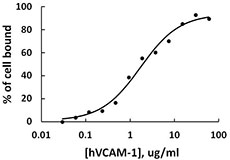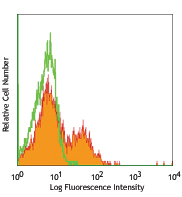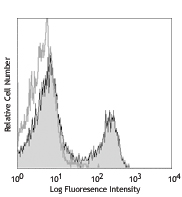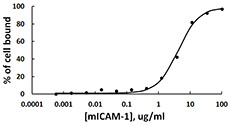- Regulatory Status
- RUO
- Other Names
- CD54, Ly-47, MALA-2, Intercellular adhesion molecule 1 (ICAM-1)
- Ave. Rating
- Submit a Review
- Product Citations
- publications

-

Retinoic acid activated HL60 cells are able to bind to immobilized human ICAM-1-Fc chimera in a dose dependent manner. Over 80% of the cells were able to bind human ICAM-1 at a dose greater than 5 µg/ml (100 µl/well).
| Cat # | Size | Price | Quantity Check Availability | Save | ||
|---|---|---|---|---|---|---|
| 552904 | 25 µg | $147 | ||||
| 552906 | 100 µg | $347 | ||||
ICAM-1, intercellular adhesion molecule 1, is a member of the immunoglobulin superfamily. Structurely, ICAM-1 is characterized by heavy glycosylation with an extracellular domain composed of multiple loops created by disulfide bridges within the protein. The dominant secondary structure of the protein is the beta sheet, leading investigators to hypothesize the presence of dimerization domains within ICAM-1. This protein is constitutively expressed at low levels on the cell surface of leukocytes, endothelial cells, macrophages, and lymphocytes. Upon cytokine activation, by cytokines such as IL-1 and TNFα, the concentration of ICAM-1 on the cell surface greatly increases. The ligand of ICAM-1 is LFA-1 (leukocyte function associated antigen 1), which is found on all T cells. LFA-1/ICAM-1 interaction has been shown to be important for T cell-T cell interactions, which leads to further T cell differentiation. ICAM-1 was found to play a role in infectious diseases, as it was identified as the binding target for entry of the major group of human rhinoviruses into various cell types and is also known for its affinity for Plasmodium falciparum-infected erythrocytes. These findings indicate that ICAM-1 may participate in the pathogenesis of several infectious agents.
Product DetailsProduct Details
- Source
- Human ICAM-1, amino acids (Gln28 - Glu480) (Accession# NP_000192.2), was expressed in CHO cells with a human IgG1 Fc tag at the C-terminus.
- Molecular Mass
- The 687 amino acid recombinant protein, with a C-terminal human IgG1 Fc tag, has a predicted molecular mass of approximately 76 kD. The protein migrates near 60 kD by SDS-PAGE in DTT-reducing conditions and near 120 kD in non-reducing conditions. The N-terminal amino acid is Glu.
- Purity
- >95%, as determined by Coomassie stained SDS-PAGE.
- Formulation
- 0.22 µm filtered protein solution is in PBS.
- Endotoxin Level
- Less than 1.0 EU per µg of protein as determine by the LAL method.
- Concentration
- 25 µg size is bottled at 100 µg/mL. 100 µg size and larger sizes are lot-specific and bottled at the concentration indicated on the vial. To obtain lot-specific concentration and expiration, please enter the lot number in our Certificate of Analysis online tool.
- Storage & Handling
- Unopened vial can be stored between 2°C and 8°C for up to 2 weeks, at -20°C for up to six months, or at -70°C or colder until the expiration date. For maximum results, quick spin vial prior to opening. The protein can be aliquoted and stored at -20°C or colder. Stock solutions can also be prepared at 50 - 100 µg/mL in appropriate sterile buffer, carrier protein such as 0.2 - 1% BSA or HSA can be added when preparing the stock solution. Aliquots can be stored between 2°C and 8°C for up to one week and stored at -20°C or colder for up to 3 months. Avoid repeated freeze/thaw cycles.
- Activity
- Immobilized human ICAM-1-Fc chimera is able to bind retinoic acid (2 µM, 72 hr) activated HL60 cells (5 x 104 /well) in a dose dependent manner. Over 80% of the cells were able to bind human ICAM-1 at a dose greater than 5 µg/ml.
- Application
-
Bioassay
- Application Notes
-
BioLegend carrier-free recombinant proteins provided in liquid format are shipped on blue-ice. Our comparison testing data indicates that when handled and stored as recommended, the liquid format has equal or better stability and shelf-life compared to commercially available lyophilized proteins after reconstitution. Our liquid proteins are verified in-house to maintain activity after shipping on blue ice and are backed by our 100% satisfaction guarantee. If you have any concerns, contact us at tech@biolegend.com.
- Product Citations
-
Antigen Details
- Structure
- Homodimer
- Distribution
-
Antigen presenting cells, endothelial cells.
- Function
- ICAM-1, expressed on antigen presenting cells, is able to engage the LFA-1 on T cells. This interaction helps the activation and differentiation of T cells upon TCR-MHC stimulation. ICAM-1 participates in leukocyte transendothelial migration. It is induced by IL-1 and TNF-α.
- Ligand/Receptor
- LFA-1, MAC-1, fibrinogen.
- Bioactivity
- Human ICAM-1 is able to bind retinoic acid-activated HL60 cells.
- Cell Type
- Embryonic Stem Cells, Mesenchymal Stem Cells
- Biology Area
- Cell Adhesion, Cell Biology, Neuroscience, Neuroscience Cell Markers, Stem Cells
- Molecular Family
- CD Molecules, Soluble Receptors
- Antigen References
-
1. Bella J, et al. 1998. Proc. Natl. Acad. Sci. 95:4140.
2. Katagiri T, et al. 1996. Blood. 87:4276.
3. Rothlein RD. 1986. J. Immunol. 137:1270.
4. Yang L. et al. 2005. Blood. 106:584.
5. Voraberger G. et al. 1991. J. Immunol. 147:2777.
6. Staunton DE, et al. 1988. Cell 52:925.
7. Greve JM, et al. 1989. Cell 56:839.
8. van Buul JD, et al. 2010 PLoS One 5:e11336. - Gene ID
- 3383 View all products for this Gene ID
- UniProt
- View information about ICAM-1 on UniProt.org
Related FAQs
- Why choose BioLegend recombinant proteins?
-
• Each lot of product is quality-tested for bioactivity as indicated on the data sheet.
• Greater than 95% Purity or higher, tested on every lot of product.
• 100% Satisfaction Guarantee for quality performance, stability, and consistency.
• Ready-to-use liquid format saves time and reduces challenges associated with reconstitution.
• Bulk and customization available. Contact us.
• Learn more about our Recombinant Proteins. - How does the activity of your recombinant proteins compare to competitors?
-
We quality control each and every lot of recombinant protein. Not only do we check its bioactivity, but we also compare it against other commercially available recombinant proteins. We make sure each recombinant protein’s activity is at least as good as or better than the competition’s. In order to provide you with the best possible product, we ensure that our testing process is rigorous and thorough. If you’re curious and eager to make the switch to BioLegend recombinants, contact your sales representative today!
- What is the specific activity or ED50 of my recombinant protein?
-
The specific activity range of the protein is indicated on the product datasheets. Because the exact activity values on a per unit basis can largely fluctuate depending on a number of factors, including the nature of the assay, cell density, age of cells/passage number, culture media used, and end user technique, the specific activity is best defined as a range and we guarantee the specific activity of all our lots will be within the range indicated on the datasheet. Please note this only applies to recombinants labeled for use in bioassays. ELISA standard recombinant proteins are not recommended for bioassay usage as they are not tested for these applications.
- Have your recombinants been tested for stability?
-
Our testing shows that the recombinant proteins are able to withstand room temperature for a week without losing activity. In addition the recombinant proteins were also found to withstand four cycles of freeze and thaw without losing activity.
- Does specific activity of a recombinant protein vary between lots?
-
Specific activity will vary for each lot and for the type of experiment that is done to validate it, but all passed lots will have activity within the established ED50 range for the product and we guarantee that our products will have lot-to-lot consistency. Please conduct an experiment-specific validation to find the optimal ED50 for your system.
- How do you convert activity as an ED50 in ng/ml to a specific activity in Units/mg?
-
Use formula Specific activity (Units/mg) = 10^6/ ED50 (ng/mL)
 Login/Register
Login/Register 














Follow Us